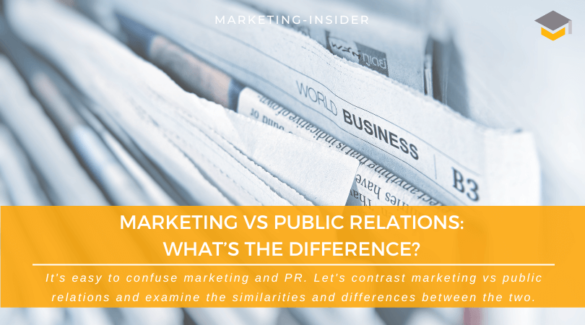MARKETING VS PUBLIC RELATIONS: WHAT’S THE DIFFERENCE?
When we think about marketing and public relations, we often think of the way businesses communicate their brand identity and product offering to us. Because of this, it’s easy to see these two business functions as falling under the same umbrella. However, while these two business areas do share similar goals in order to work towards an overall company strategy, the two functions are actually very different entities. In order to make the best business decisions, it’s therefore important to understand how marketing and public relations work differently. In this article, we’ll be discussing the similarities and differences between marketing and PR, as well as how these two functionalities can be combined to create an effective business strategy for a range of organizations. Marketing vs public relations – read on to learn more.
What is Marketing?
Marketing is a business function that encompasses a wide range of different departments and subsections that make up how a business attracts new customers and encourages existing ones to stay with them. Due to the way marketing drives new sales and boosts business growth, it’s a vital concept for businesses to get right, especially if they are pitching new ideas to external stakeholders or investors. While some people might see PR as being under the marketing umbrella, it’s more accurate to see these two concepts as separate areas, as marketing focuses primarily on direct customer communications. There are many different styles of marketing, but the ones that may be most familiar include:
- Outbound Marketing:
As one of the most popular marketing strategies implemented by businesses, outbound marketing might be most familiar to you. This involves companies creating advertising materials or content that address customers directly by reaching out to them through a range of communication channels such as television and radio. The aim of most outbound marketing campaigns is to create a buzz around a product, and sell to people who might not have realized that it existed, or that they needed it before. While this strategy does require pitching to customers through adverts that customers aren’t searching for themselves, outbound marketing has been proven to be a successful tactic time and time again.
- Inbound Marketing:
Inbound marketing developed as an evolution of the outbound strategy, but instead of reaching out to customers with an offer, inbound marketers wait for potential customers to make the first move and initiate contact with the company. To encourage this, marketing teams will create a large collection of original content such as articles, blog posts or guides that provide value to any customers who are searching specifically for that content online. This establishes a company as one that is positive for a consumer, and increases their risk of returning to the company in the future.
- B2B Marketing:
B2B, or ‘Business to Business’ marketing does what it says on the tin – this is where businesses will develop relationships with other companies in order to make deals with them. This is an effective way of advertising for companies who sell in bulk or price for a more competitive wholesale market. Due to the nature of B2B marketing, less PR management may be needed for these campaigns, but this is still an area in which businesses should invest some time and energy.
Let’s now define public relations, before contrasting marketing vs public relations.
What is PR, and Why is it Important?
Like marketing teams, PR professionals also develop strategies for running a business that focus on the long-term impression that a company is leaving with any clients, stakeholders and investors. The key to successful PR lies in the ability of businesses to form a healthy, long-term relationship with clients that isn’t damaged or negatively impacted by the media or other external sources.
Because of this, PR teams have some very specific goals designed to manage any disruption and promote the business to the media. For instance, media training and press conferences are key elements of any PR role, as they manage disputes that may arise from mistakes being made within the team that reduce the impact of the brand image. Within these PR roles, there are many different strategies that you could consider prioritizing within your own organization:
Media Relations
One of the biggest strategies of any PR team is media relations. This involves a huge variety of daily tasks that share the aim of drawing media attention towards a company. This media attention revolves around journalists and broadcasters who have the potential to share information about the organization through their platforms and other channels. PR strategies are therefore designed to target specific media outlets so that the business can strengthen the connection between them and their external stakeholders, and cement the overall impression that they receive.
While there are many different ways, both paid and unpaid, that PR teams actually get in contact with media outlets, the outcome should be the same – the media should be promoting the business in a positive light.
Crisis Management
Due to extensive media relations strategies that are implemented by PR teams for all kinds of companies, it’s easy to get this technique confused with crisis management, a strategy that also deals regularly with the media. However, as opposed to media relations, which draws attention towards an organization, crisis management involves encouraging media attention away from a company, usually after an employee or product has acted in a way that results in a poor public image.
For example, if an employee uses social media in a way that draws negative attention, or is spotted publicly acting in an unprofessional manner, this can lead to unwanted consequences for businesses, so it’s down to a PR team to manage the crisis and resolve the dent in public perception. PR specialists will elaborate on what happened, be transparent about the event and subsequent process, and work to divert attention towards more positive aspects of the business. This can be done through a range of channels, including both traditional and social media coverage. There are a whole number of ways that you can track the effectiveness of a crisis management strategy, so it’s a great way for businesses to understand what they are doing well.
Employee Communications
While PR is often perceived as being primarily based in media and crisis communications, there are some other strategies that these teams take ownership of, such as employee communications. Positive employees who share the same outlook are vital for the success of any business, especially if a crisis has occurred which leaves some people doubtful around the organization.
PR teams therefore work closely with employees, ensuring that communication surrounding internal issues is provided in a timely manner, and that workplace procedure is followed consistently. It’s also the role of PR teams to make sure that employees feel valued within an organization, and this can be done through a range of planned events and awards.
Now that we know what PR is and why it is critical to an organization’s success, let’s dive into marketing vs public relations to understand the similarities and differences between marketing and PR.
Marketing vs Public Relations
If you’re a business owner considering how best you can improve your overall strategies and drive sales numbers, then thinking about marketing vs public relations can be a good way to do this. After all, there are some interesting similarities and differences between the two functionalities that are important to grasp when hiring employees and cementing your business plans.
Similarities Between Marketing and PR
It’s easy to confuse marketing and PR, due to the similarities between these two functions – there are lots of areas in which marketing and PR draw on the same techniques and motivations to fulfil their objectives, such as:
Brand Identity
Both marketing and PR teams build on the overall objectives of a brand by appealing to their target audience. For marketing, this is done through a variety of methods, like researching the market and implementing strategic advertising methods that highlight either the brand identity or the products available. It can involve using both inbound and outbound methods to attract and retain customers who are interested in the company. Similarly, PR teams place brand identity at the core of their work, as they are involved in the resolution of disputes, crisis management and media relationships.
Content Marketing
In order to promote a clear and convincing brand identity, both marketing and PR use similar strategies around content marketing to drive their objectives. Marketing teams, especially when prioritizing inbound marketing, create a large range of original content that aims to promote a brand and increase sales. This can include social media posts, website content like blogs and articles, and even radio or podcast appearances. PR teams use content creation too, especially if trying to mitigate public backlash or negativity surrounding company activity.
Metrics For Success
Due to the many shared strategies that PR and marketing use, the two business functions are often measured on similar data points to rate their success and performance. Although many PR metrics are measured on media engagement and positive impressions within a business’ local and wider community, many of the data points through which both PR and marketing are measured are actually very similar. These include:
- Response time – as a lot of business activity is moving increasingly online, it’s becoming easier for companies to track their response time – both marketing and PR teams are now able to see the exact time and date that a person or organization reached out to them, and can therefore easily track how long it took to get back to them with a response.
- User engagement – user engagement defines the process of tracking visitors to a business’ website or social media page, taking note of the time they spend consuming their content and whether they subsequently engaged with it, for example by subscribing to a newsletter or following a link to a product page.
- Social media data points – a clear giveaway for the success of many companies in the modern age is how well their social media sites are performing. Thanks to many social media channels like Facebook and Instagram giving a clear idea of how many ‘Likes’ or ‘Follows’ a business has, the marketing and PR teams within that business can structure their strategies effectively, with an understanding of exactly what customers want to see.
The Differences Between Marketing and PR
While marketing and PR do share a large range of similarities, their functionalities are more different than many would expect. Indeed, one of the biggest differences between marketing and PR is how departments within these businesses actually operate.
- Different objectives:
Although both marketing and PR works to further the overall aims of a business, such as increasing sales revenue or growing the brand identity, the two areas differ in their specific objectives. Marketing aims to promote the brand directly to customers, whereas PR teams work to resolve any issues that affect the image of the brand in the public eye, and that of their investors or stakeholders.
- Target audience:
Although marketing and PR work towards a similar brand strategy, the target audience for this work differs across these two business areas. While marketing teams focus primarily on the acquisition and retention of customers, PR teams focus their efforts on a far greater range of people and groups, such as external stakeholders and the media. This means that often, the approach that they take to achieving their targets is varied between the two departments, as the message they need to send will be different depending on who they are trying to reach.
- Operations:
Because of the varying objectives and target audiences of marketing and PR teams, the areas of operation in which they work are different. Projects carried out by marketing teams typically involve researching the market alongside a business’ target audience to plan a product’s journey to market and subsequent promotion. On the other hand, PR teams are required to work more closely with external organizations and individuals to uphold a positive brand image. This means that their line of work often aligns more closely with external environment activities.
Combining Marketing and PR Strategies
Due to the similarities and differences between marketing and PR, it’s important that businesses take a flexible approach to implementing their strategies. Keeping marketing vs public relations separate may not be the best option. One of the best ways to do this is by combining your marketing and PR strategies, which will not only allow you to streamline your processes for outreach and acquisition, but also allows you to focus more closely on the brand message that you want to promote. By doing this, you will in turn unlock a greater range of content for both areas of the business, with original content being utilized to more effectively tell the story of your company. Ultimately, only you can decide what’s best for your business when considering marketing vs PR. Your employees will have different visions and goals for the future, but by consulting with them on the variations within their work, as well as potentially combining these two key business functions, you can ensure that your biggest business successes are still to come.

![[Pics] Did You Know That She Was This Tall We Had No Idea [Pics] Did You Know That She Was This Tall We Had No Idea](https://images.outbrainimg.com/transform/v3/eyJpdSI6ImFiYmJjZjhjYjI4YjBhMTM1YTYyZmMwM2E4OThjMDllZGVjMDJiOTZkMjFjYTE1MTFjMjdhOGRmY2ZlNjQwZDMiLCJ3IjozMDAsImgiOjIwMCwiZCI6Mi4wLCJjcyI6MCwiZiI6MH0.jpg)



![[Photos] 35 LGBT Celebs Who Are Couples And You Probably Didn't Know [Photos] 35 LGBT Celebs Who Are Couples And You Probably Didn't Know](https://images.outbrainimg.com/transform/v3/eyJpdSI6ImZiYzFhZDNkNmVkMGJmOTBkNjYyNzIzZTM4NjYwYzNmMDU2OTUzZjRjYWVlZjI3NjNiN2NmMGI4Y2JlOTkzNzEiLCJ3IjozMDAsImgiOjIwMCwiZCI6Mi4wLCJjcyI6MCwiZiI6MH0.jpg)
![[Pics] Always Put a Plastic Bottle on Your Tires when Parked, Here's Why [Pics] Always Put a Plastic Bottle on Your Tires when Parked, Here's Why](https://images.outbrainimg.com/transform/v3/eyJpdSI6ImJkN2FmMzVkOGM2YjAzN2ViZGQ2MDlmOTUxNTZjYWQxM2UyNjY0YjNmMDNkNTQwOWU2NzhkZGM4MGRjODRjNmEiLCJ3Ijo0MDAsImgiOjI2NiwiZCI6Mi4wLCJjcyI6MCwiZiI6MH0.jpg)

No comments:
Post a Comment